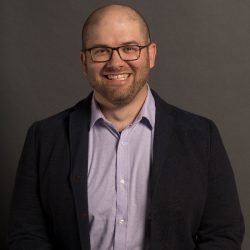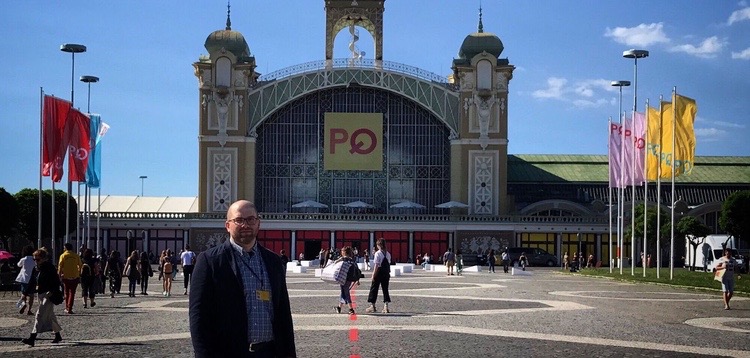Spotlight on Faculty: Ian Garrett
This month we’re shining our spotlight on Ian Garrett, from the Production/Design Area of the Department, who returned this year from his Sabbatical.

1. Who are you?
The phrase I have in one of my email signatures is “Performance Infrastructure Engineer”. I thought I was going to be an architect, but early in my career, spurred on by going to the Prague Quadrennial in 2003, I turned to scenography. For most of my freelance career I worked primarily as a lighting and media designer, with a decent amount of scenic design. I tend to have been a designer in a variety of devised contexts, spending 10 years as the resident designer for the Indy Convergence, a residency that is a bit of a new work incubator. This was typically balanced with arts administration work producing original work and working in communications and marketing. Basically I tried to do everything to support new performance work, but I’m not interested in performing myself. I also start to adapt a lot of the sustainable building training I had in Architecture school to my theatre practice around 2005. That turned in the Centre for Sustainable Practice in the Arts, a think tank I direct that does research and a variety of projects related to Sustainable Development and the Arts.
2. Tell us about a creative or research project that you have been immersed in recently.
One of my more active projects at the moment is a project called TrailOff. It’s a collaboration between Swim Pony Performing Arts in Philadelphia and my company Toasterlab. We’re developing immersive audio experiences for 10 sites along the circuit trail system surrounding Philadelphia with local writers. These will be experienced using a bespoke mobile application which uses information about your location, the time of day, the weather, etc. to responsively deliver the narratives as users walk the trails. That’s going to be launching in June. For me and Toasterlab it is part of our larger project in which we’re developing an open source platform for combining performance, location, and mixed reality content.
3. What production or artist or scholar has had the most impact on you over the course of your career?
There are a few people that have been instrumental in my career. Kevin and Trish Rigdon took me under their wings when I was still studying architecture and continue as mentor figures. They were the ones who spurred me on to attend the Prague Quadrennial originally, and this year I served as Curator for the US at the PQ with Kevin as the Artistic Director. Also Mark Ramont, a director who guided me a lot in my early career. Other key mentors have come from the producing side like Sixto Wagan, Carol Bixler, Leslie Tamaribuchi.

There are a lot of influential artists out there that have also shaped my work. Dorita Hannah fits as both as scholar influencing my thinking about space and performance architecture, and as an artist her “Heart of the PQ” design was sort of the first time I really saw the possibilities of thinking about an expanded scenography and architecture practice. In grad school I was assistant producer on a Richard Foreman opera and got to spend hours with him talking about how he came to create work (I have an icon he gifted me in my office). Phil Soltanoff is a director I really like, and I often quote his show “An Evening with William Shatner*” (the asterisks is important, since William Shatner isn’t physically in the show). Also, Teresa J. May (not to be confused with the former UK PM) and Una Chaundhuri on their writing around EcoDramaturgy.
The list could keep going!
4. Is there an image or a quotation that inspires you?
A couple I keep close in mind:
“…And the important function of play is thus revealed: it permits us to gain, without any particular future application in mind, a holistic understanding of the world, which is both a complement of and a preparation for later analytical activities.”
– Dragons of Eden: Speculations on the Evolution of Human Intelligence by Carl Sagan
“The faculty of art is to change events; the faculty of science is to foresee them. The phenomena with which we deal are controlled by art; they are predicted by science.”
– Henry Thomas Buckle, The Influence of Women on the Progress of Knowledge,’, a discourse delivered at the Royal Institution (19 Mar 1858)
“I think of art, at its most significant, as a DEW line, a Distant Early Warning system that can always be relied on to tell the old culture what is beginning to happen to it.”
– Marshall McLuhan
There is a long one I use a lot from the Soltanoff show I mentioned, but It might be a little long to share.
5. What’s the first meaningful action you took after the start of your sabbatical?
Take my son to his first day of JK at his new school. Because of the remediation period after the strike ended (sorry to bring it up), my sabbatical started in September. I worked out my project schedule so that I wouldn’t be out of town for more than a week at a time, typically only ever once a month. But that meant I was home and could do drop-off and pick-up for my kids, and take on much of the household management for the year. It was a super special thing to be able to be available to my family while working on my sabbatical projects right from the start. My partner was still working full time at the time and it meant we didn’t have to figure out before and after school care and only see each other first thing in the morning and at dinner time.
6. What are some of the projects you undertook during your sabbatical?
One of my big projects was serving as the Curator for the US for the Prague Quadrennial, or the PQ. Its the largest gathering around performance design and space in the world, and as the name describes, it happens every four years in Prague. The curation started before my sabbatical, but there was an exhibition to build and content to collect. The exhibition was built at the University at Buffalo, which was convenient insofar as I could get there and back on the same day while it was being constructed. I also built the digital interface for the exhibition which is mirrored online (http://pq19.usitt.org/). There were 50 designers or design teams included in the national exhibitions, 22 of which who were featured in a podcast series and short videos I produced as well. I travelled to Prague for the PQ in June and brought a dozen York students will me. I also ran a workshop on the use of Mixed Reality with Site Specific performance, and led a program called Light Spot with my colleague Beth Kates. Light Spot was a space dedicated to conversations on lighting and media technology in performance.
I also completed a number of projects with my company Toasterlab. This evolved out of a project called Transmission which I produced for a premiere in Edinburgh in 2017 which had elements in The Edinburgh International Science Festival, the one-time FuturePlay festival as part of the Fringe, and then the Future of Storytelling Festival in New York. This work is on the use of mixed reality technology and site-specific live performance. One of the big projects for the company has been one called Groundworks, which is a collaboration with indigenous artists in Northern California about using traditional and contemporary Indigenous performance that has been geo-located to “re-story” the land.
We did a project in North York in Parkway Forest Park where we did a VR workshop for youth, a pop-up VR cinema, and built a web-app for exploring the park through VR films the participants created. (You can interact with the following 360° VR video by scrolling the image.)
I did a couple of projects with the choreographer Jane Gotch including a VR film in the TTC, and then another geolocated series of VR dance films along the streetcar in Kansas City. With Dopolavoroteatrale (aka DLT Experience) I produced a VR component to their immersive production The Stranger 2.0 and during this time we started TrailOff with Swim Pony in Philadelphia too. And I did do some more conventional theatre (sort of), lighting Remembering the Winnipeg General at the Owl’s Club with Zietpunk Theatre over the summer.
I’ve also worked on the National Arts Centre’s cycle on Theatre and Climate Change, and continue a lot of that research and advocacy work.
7. What insight or discovery did you make during your sabbatical?
I think one idea that has emerged for me is about the future of theatrical performance and emerging mixed reality technologies. I’ve found that one of the interesting barriers to this type of media adoption is that a lot of it has been created out of a cinematic practice, and that asks those that are used to working with framed camera-based forms to throw out a lot of technique. The camera might be technically similar but you can’t zoom… you move closer. You can’t pan… you turn your head. And I’ve found that this is actually more akin to theatrical staging, especially immersive performance.
Another thing that has become apparent is that in the realm of sustainable arts practice there is a hugh uptick in consideration. I was discussing with a colleague at Julie’s Bicycle who has also been thinking on this movement for over a decade and we noted how the field has grown incredibly in the last year even. Where we thought maybe we were losing touch with everything, we both sort of saw that it’s really that there was so much going on we couldn’t keep it all in mind at one time like we used to. And there are so many more people interested in this topic, our great existential crisis, that it’s become more hopeful than before.
8. How will you integrate what you learned/discovered during your sabbatical into your teaching?
I’m starting a new studio class in this Winter called EcoScenography. Part of this has been about bringing all of these ideas that I’ve been exploring together into something I can work on with students. This will integrate the work on site-specific performance, community based work, the integration of location-based technology, collaboration with indigenous communities, etc. I’ve wanted to do something like this since I came to York, but the teaching needs of the department and my loading didn’t allow for it until now. We’ve had some new faculty in Design and Production come on-board and so some of my classes that I taught before my sabbatical have moved to them. It’s always exciting and terrifying starting a class from scratch, but it’s looking like it’s going to be a great way to really bring all this work together and continue the available offerings on sustainability and performance, adding to my existing course which is more of a studies approach.
With all of the activity in the field, there is also a possibility that we might see a bit more in our Theatre@York season in the coming years to better integrate sustainable thinking and expanded performance practice. We’ll see how that shapes up, but my sabbatical has really energized me to advocate for thinking about the future of performance.
https://vimeo.com/346390654/89ca09c40f